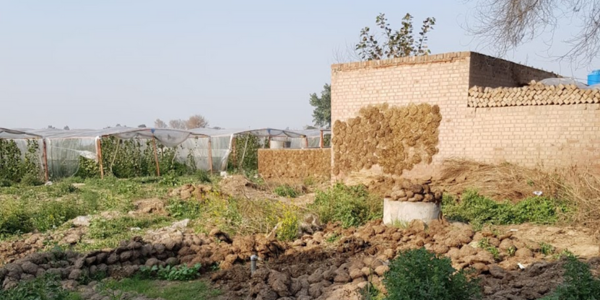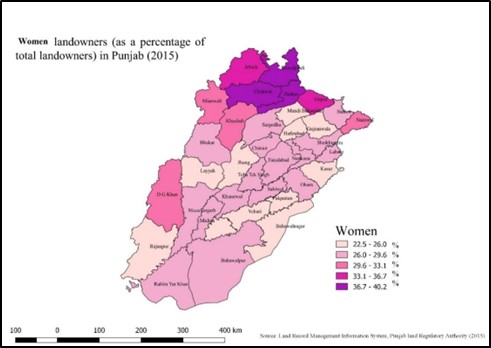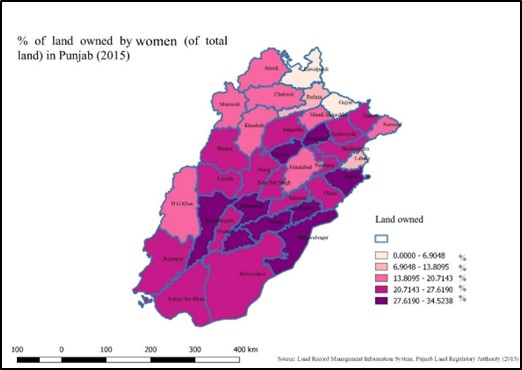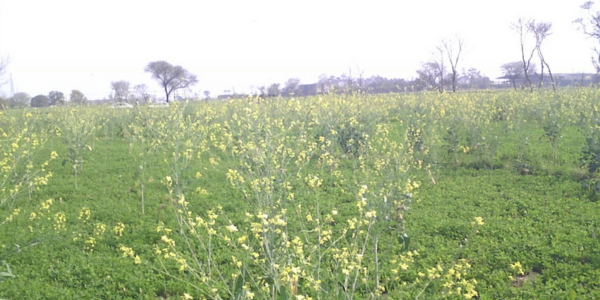By Hana Zahir
Protecting women’s land rights is a necessity for ensuring women’s empowerment (Agarwal, 2003). Land is a critical source of revenue through which women can secure subsistence and collateral. Therefore, enforcing and introducing legal reforms to protect women’s land rights, is a positive step that policymakers can take to empower women. However, these reforms come with many limitations. Although such reforms increase formal access to land for women on paper, they do not address the question of who has decision-making power over the land. In addition, such reforms may not account for other factors that might exacerbate oppression such as race, class, and caste. For these reasons, such reforms need to be re-structured to have the greatest impact on women. This blog uses administrative data and qualitative fieldwork with women landowners in Punjab (Pakistan) to demonstrate that even in cases when women have legal titles over the land, patriarchal social norms limit women’s ability to utilize their land rights effectively.
What is the difference between access and control for women?
Understanding the difference between “access to” and “control of” a resource is particularly important because those who legally own the land may not be the ones who are benefitting from that resource. In this article, I understand access to land as “legally and socially recognized and enforced by an external legitimized authority, be it a village-level institution or some higher-level judicial or executive body of the state” (Agarwal, 1994), and define control over land as “opportunity or agency of choice” as described by (Kabeer, 1999).
Most household surveys indicate that women gain access over land when the legal title is transferred into their name. My fieldwork suggests that women also consider themselves to have access over land if the rent from the land, or the revenue obtained from the sale of crops, is allocated to them even if the legal title of the land parcel is not in their name. On the other hand, control is limited to the power of selling a land parcel without the permission of other members of the household. My fieldwork indicates that all aspects of decision-making, including having decision making power over when and whom to sell the land to, at what price to sell the land, and what to grow on the land are all considered areas of empowerment for women. It may also involve control over how the land and/or the revenue generated from the land is utilized. While “access to” land may be documented through legal titles, “control over” land refers to the ability of women to reap the benefits of a specific resource both in the current time and in future expectations, transfers and claims (Kabeer, 1999). However, in order to challenge patriarchal gender norms, which lead to the marginalization of women from the decision making process, it is not enough to ensure the implementation of existing land right laws.
While control over land parcels is less tangible and more difficult to measure, it is critical that we understand the dynamics that underpin women’s control over land as it is a more accurate measure of women’s position under current land rights.
One particular problem with the national agricultural census is that it reduces the question of access and control over land to a simple “yes-no” binary at the household level. However, measuring access over land as a binary variable does not account for who within the household owns the land or how they acquired it, making it difficult to determine if women are the primary decision makers (Deere, Grown & Doss, 2007). Measuring the concept of control is even more complicated because day-to-day management of land parcels comes under the purview of men. Even if women own the land and take decisions regarding the management of the land parcel, most of the decision-making takes place within the household. In some households that I interviewed, I found that even when women did not formally own the land parcel, they were able to take operational decisions related to the land parcel, as well as the revenue generated from the land parcel. In doing so, these women increased their overall empowerment.
These measurement dilemmas make it difficult to develop a nuanced understanding of power dynamics pertaining to access and control over land. This complicates the bid to improve women’s access and control over land, particularly since the relevant data is not available. Measuring women’s access and control over land requires a better understanding, identification, and mapping of factors through which access can be gained, maintained, and controlled. Therefore, access and control over resources as concepts should be viewed as a spectrum of possibilities than a simply dichotomous outcome.
Photo Credit: Author’s own of village visits in Punjab (Pakistan)
Background on women’s land ownership in Punjab (Pakistan)
Women’s legal rights over land are well-defined in Pakistani legislation. In fact, a majority of women in Pakistan do own land. This blog focuses on land ownership in Punjab, one of the provinces of Pakistan. This province was selected because agriculture is the main source of income for most households and because the provincial government has introduced many reforms specifically targeting women’s ownership of land. In 2012, the government of Punjab introduced enforcement mechanisms to ensure that women had access over their land as part of their inheritance rights when their father or husband passed away. To fortify this process, the state entrusted land officials to ensure the transfer of women’s legal share of land into their name in the event of the death of the head of household. However, despite this intervention from the government, high geographical variation remains across the province with respect to women’s ownership of land (Punjab Land Regulatory Authority, 2015). Figures 1 and 2 (below) show the percentage of women landowners and the percentage of total land owned by women across the province of Punjab.
Figure 1: Percentage of women landowners by district in Punjab (Source: Punjab Land Regulatory Authority 2015)
Figure 2: Percentage of land owned by women by district in Punjab (Source: Punjab Land Regulatory Authority 2015)
Less than 40% of the landowners in any part of the province are women but this falls to less than 30% in most districts (Figure 1). Most women landowners are concentrated in the northern part of the province. The amount of land owned by women is also on average low (Figure 2). The highest percentage of land owned in any district of Punjab is 35%. Women are more likely to own bigger tracts of land in the central and southern parts of the province. The data on women’s land ownership indicates that variations exist in women’s land outcomes across the province of Punjab despite the enforcement of legal reforms. This may arise due to variations in land parcel sizes across the province of Punjab or the fact that land ownership may be concentrated within a few households. It is also important to determine whether there are differences in access and control over land in reality for women landowners.
In order to verify that differences exist in women’s land outcomes, I conducted qualitative interviews with 12 landed households across the province. The households were not picked from a random sample. Each household is classified as a large, landed estate (150+ acres) by the Agriculture Census of Pakistan. In this way, variation in women’s land ownership is not muddled by the size of the household’s land holdings. A snowballing technique was used to approach these households since most households would not agree to be interviewed without someone vouching for me. The women selected from each household were 25-40 years in age and married. This choice in interviewees was necessary as it would have been difficult to obtain permission to interview underage women. Furthermore, married women could also compare land ownership patterns within their natal as well as marital households. This age cohort was specifically selected since they would have information about the household’s previous, present, and future dealings with women’s land outcomes. Most of the women interviewed were not employed outside of their household’s own economic interests.
Photo Credit: Author’s own of village visits in Punjab (Pakistan)
Findings from the field
Women respondents reported that access and control are not as binary in nature as household surveys suggest. Women who have the land legally transferred in their name may be unable to benefit from the revenue of the land. Even women who have control over the revenue from the land, may not be able to sell the land without permission from a male member of the household. Some women didn’t have the land transferred in their name but are paid the revenue obtained from the land.
Given the prevalence of traditional gender norms coupled with the patriarchal nature of agricultural markets, most women from landed families remain dependent on male members of the household for support in mobility and dealing with administrative land issues. However, due to the strong entrenchment of patriarchal norms, most women would be satisfied with gaining control over their land. However, in order to truly empower women, we must work towards ensuring women’s access and control over land. Holding formal titles over land can only help women to a certain extent in gaining empowerment if they cannot exercise control over the revenue generated from the use or the sale of the land. In some situations women had to split some percentage of the revenue generated from their land parcel with another male member of the household (such as a brother or husband). The household bargaining model assumes that if women’s fallback options increase through better land access reforms, women’s threat utility will increase. However, this does not seem to be the case.
Despite the promulgation of gender friendly land reforms in Punjab, women from landed households remain dependent on their household to honor said rights over land. This situation is largely due to the fact that there is a need for the support of other male members of the household. In fact, my fieldwork suggests that, within landed households, the dependency on a single source of revenue (namely cultivation), coupled with the prevailing social order of different groups, creates interlinked relationships between households and kinship groups. Furthermore, women from landed households feel that there are existing gender biases within formal institutions which would prevent them from obtaining their rights. Such fears, coupled with increased social sanctions and shaming of women who do pursue land dispute cases, lead to hesitation on the part of most women in pursuing access over their land.
In fact, winning access over land through a land dispute case still does not ensure that women gain control over their land rights. In some cases, land disputes may only result in a transfer of control from one male relative (for example, her brother) to another male relative (her husband or son). All these different obstacles cause women to settle for “control” rather than “access” to their land rights. This is particularly true as this arrangement has the greatest chances of maximizing the benefit accrued to them. This is especially true for women in Punjab, where male relatives are likely to control the resource and benefit from the income in practice, even if the formal access and ownership of the land is bestowed to a woman.
Conclusion
Policymakers, economic theory scholars, and researchers need to center women’s empowerment when pursuing land right reforms. Although providing formal titles to women should lead to higher empowerment, if women do not control the operations and revenue from the land parcel, they may not benefit in the long run. Women who managed to control the land parcel without formal access seem to benefit more than women who gain only formal titles over land. Furthermore, underlying relationships and norms which impact both women’s access and control over land should be measured empirically to improve existing gender norms surrounding land rights. In this way, women can receive the maximum benefit from gender-friendly reforms.
 Dr. Hana Zahir is a Visiting Assistant Professor at the Department of Economics, Lahore University of Management Sciences (LUMS), and the Uma Lele Fellow for 2023. She completed her PhD from SOAS. Her research interests lie in gender dynamics, household bargaining, and agricultural economics.
Dr. Hana Zahir is a Visiting Assistant Professor at the Department of Economics, Lahore University of Management Sciences (LUMS), and the Uma Lele Fellow for 2023. She completed her PhD from SOAS. Her research interests lie in gender dynamics, household bargaining, and agricultural economics.





